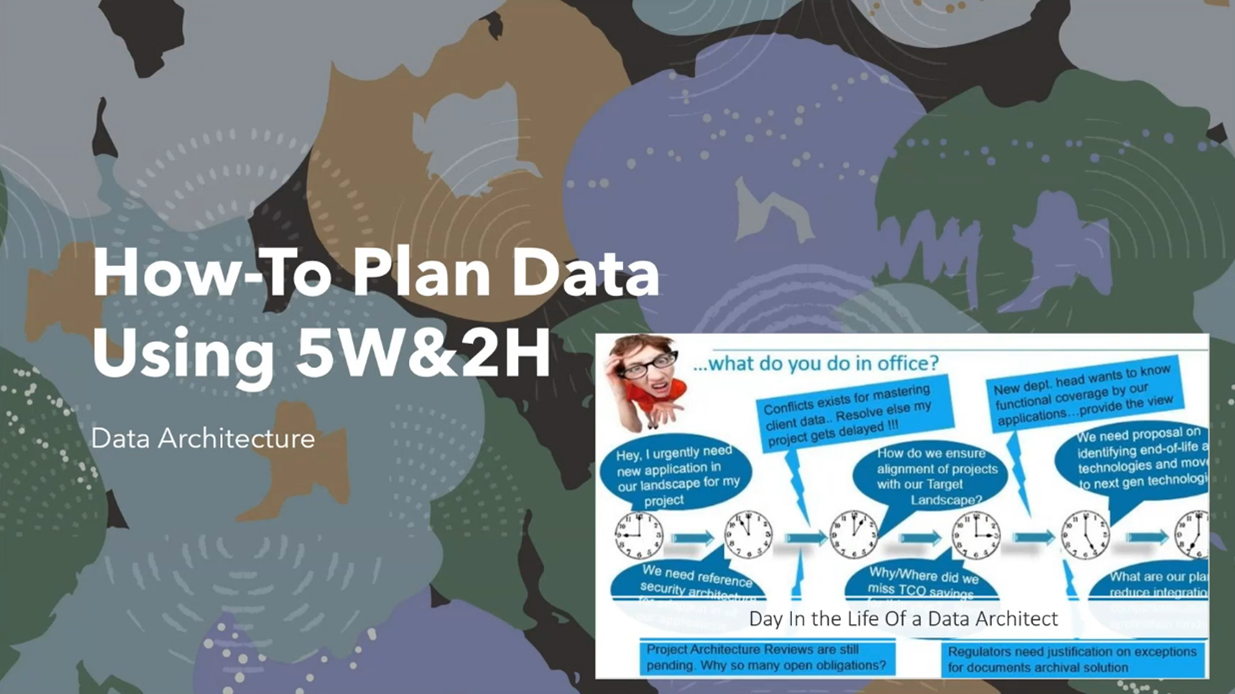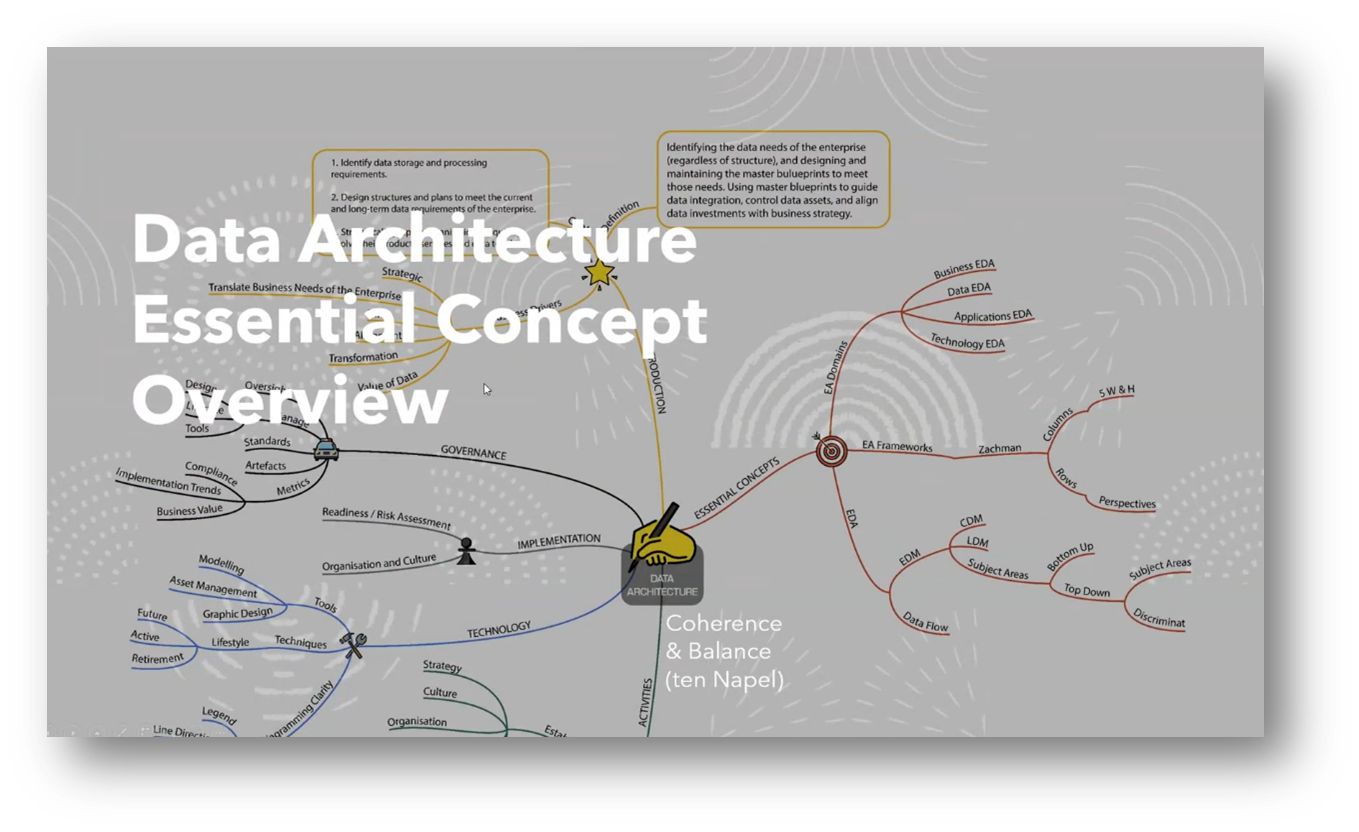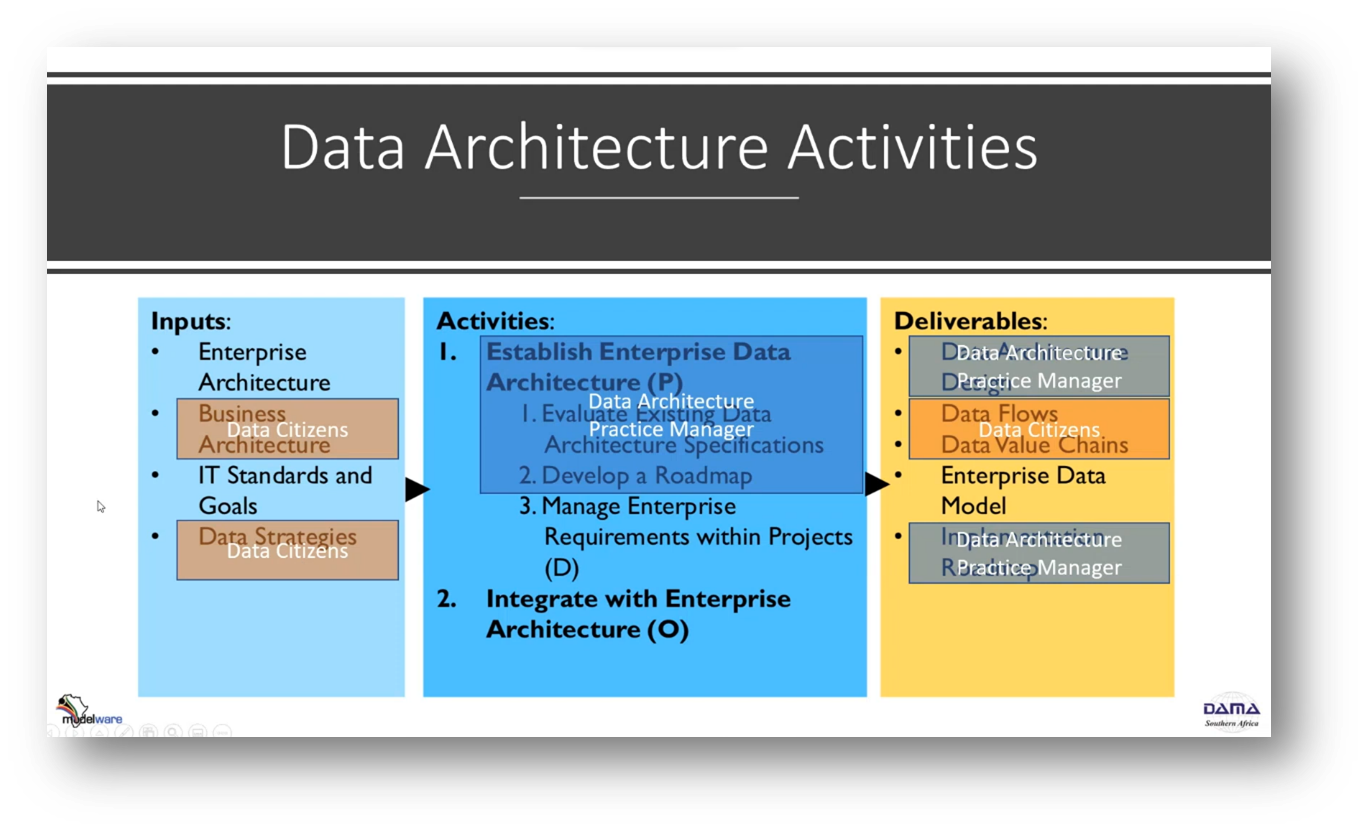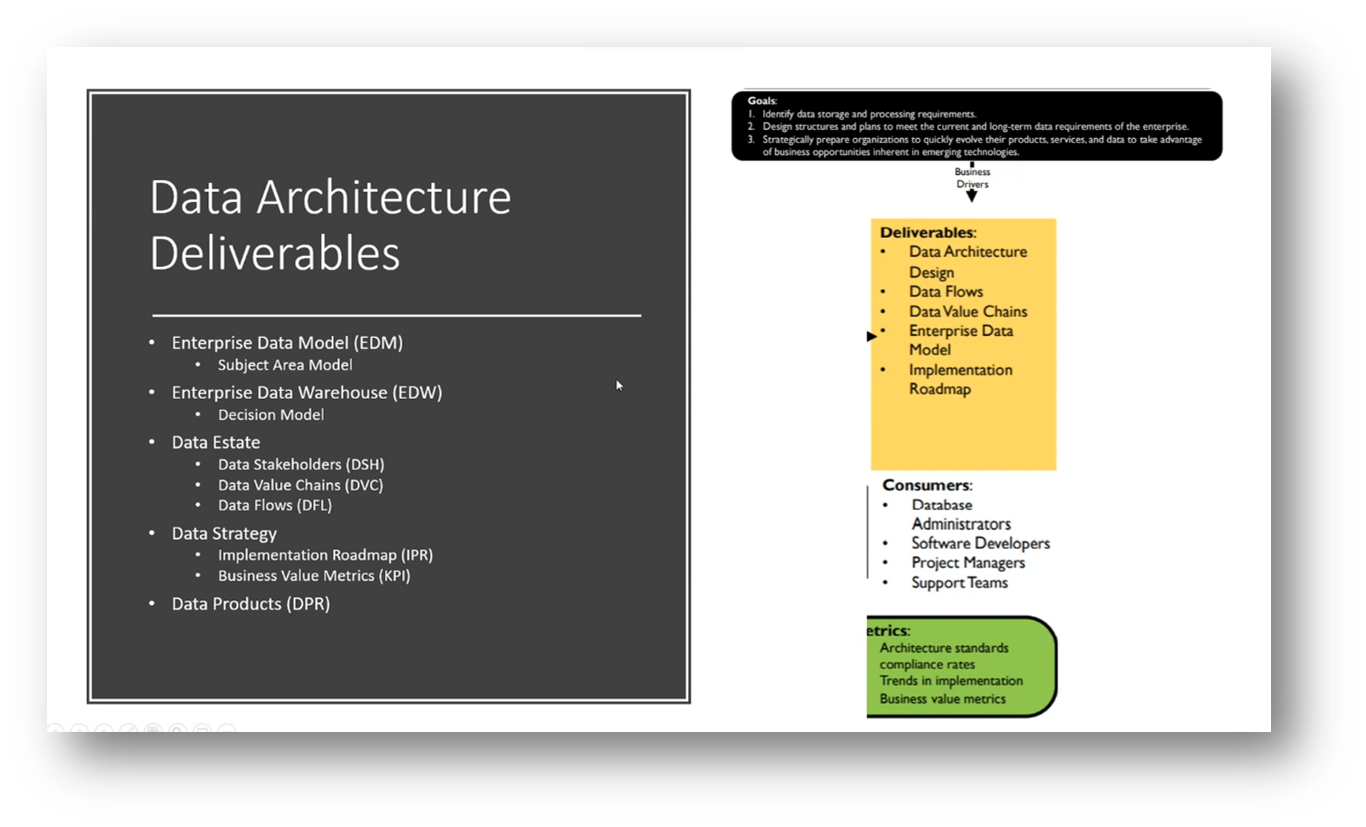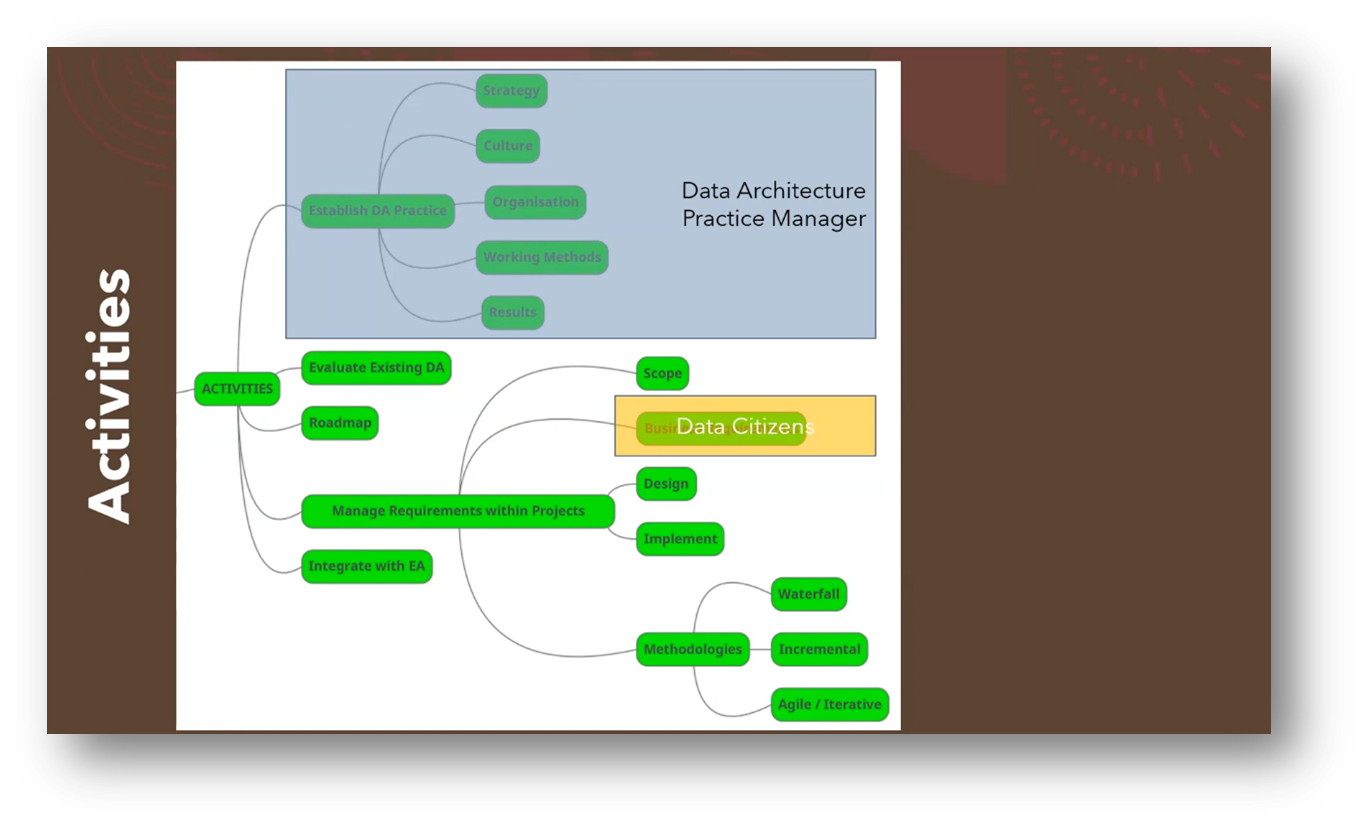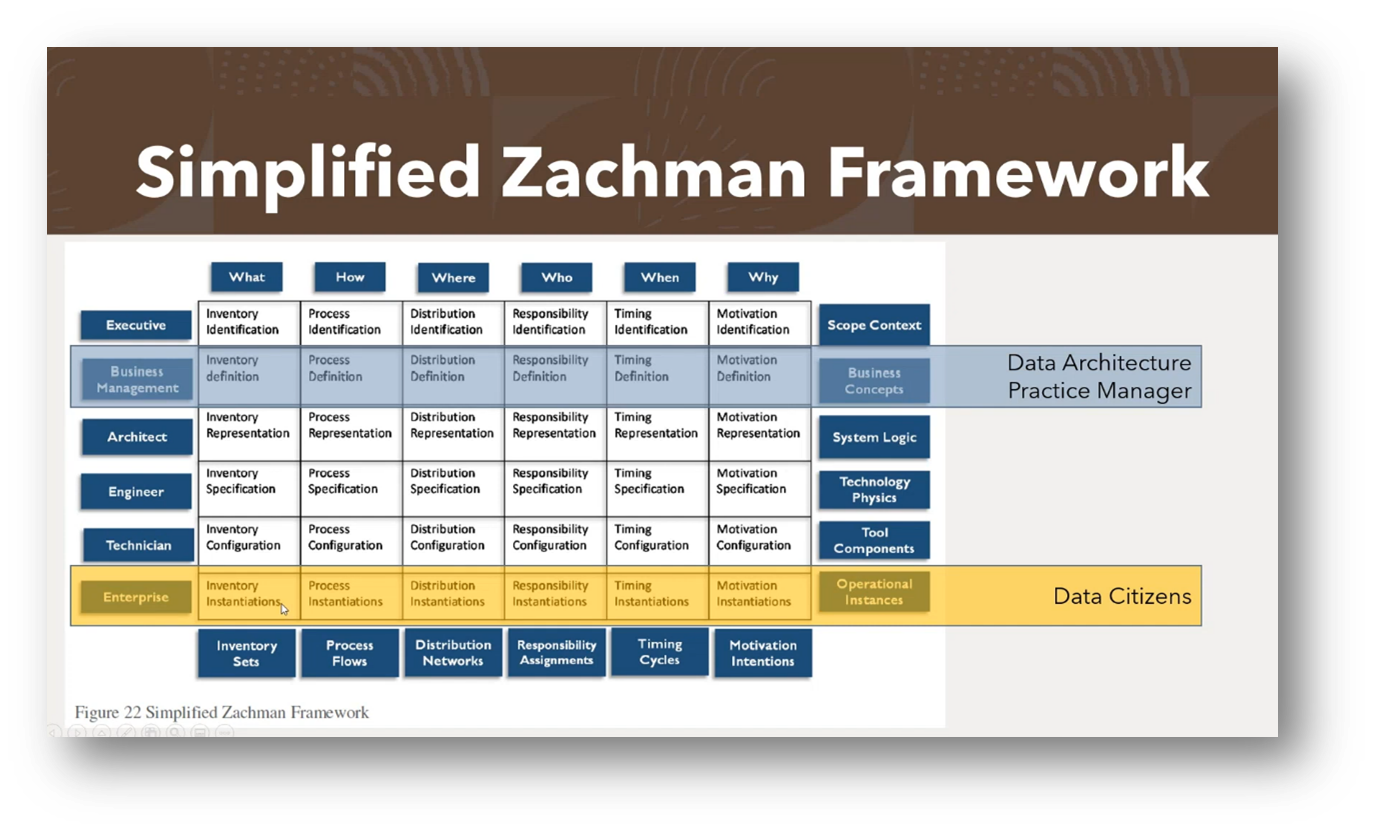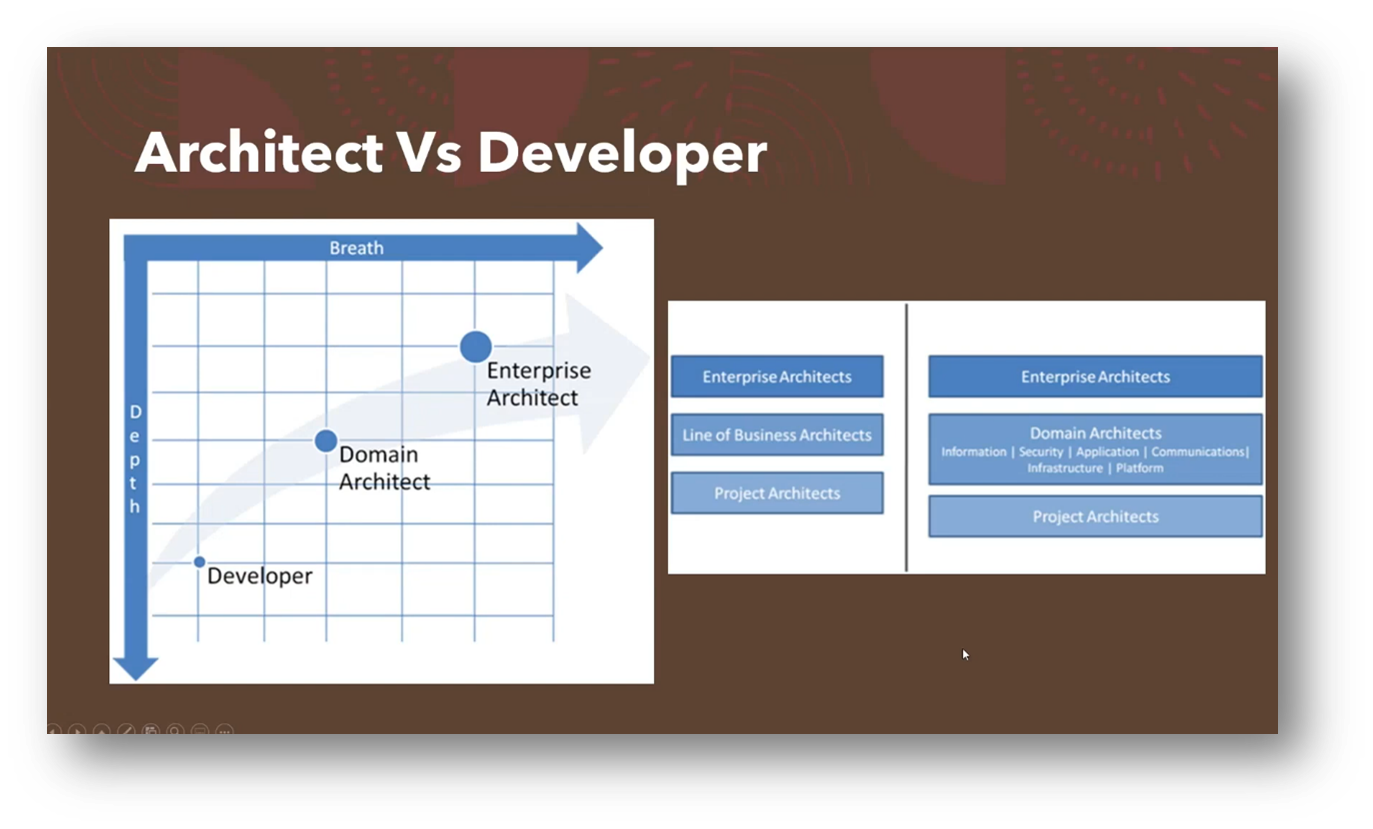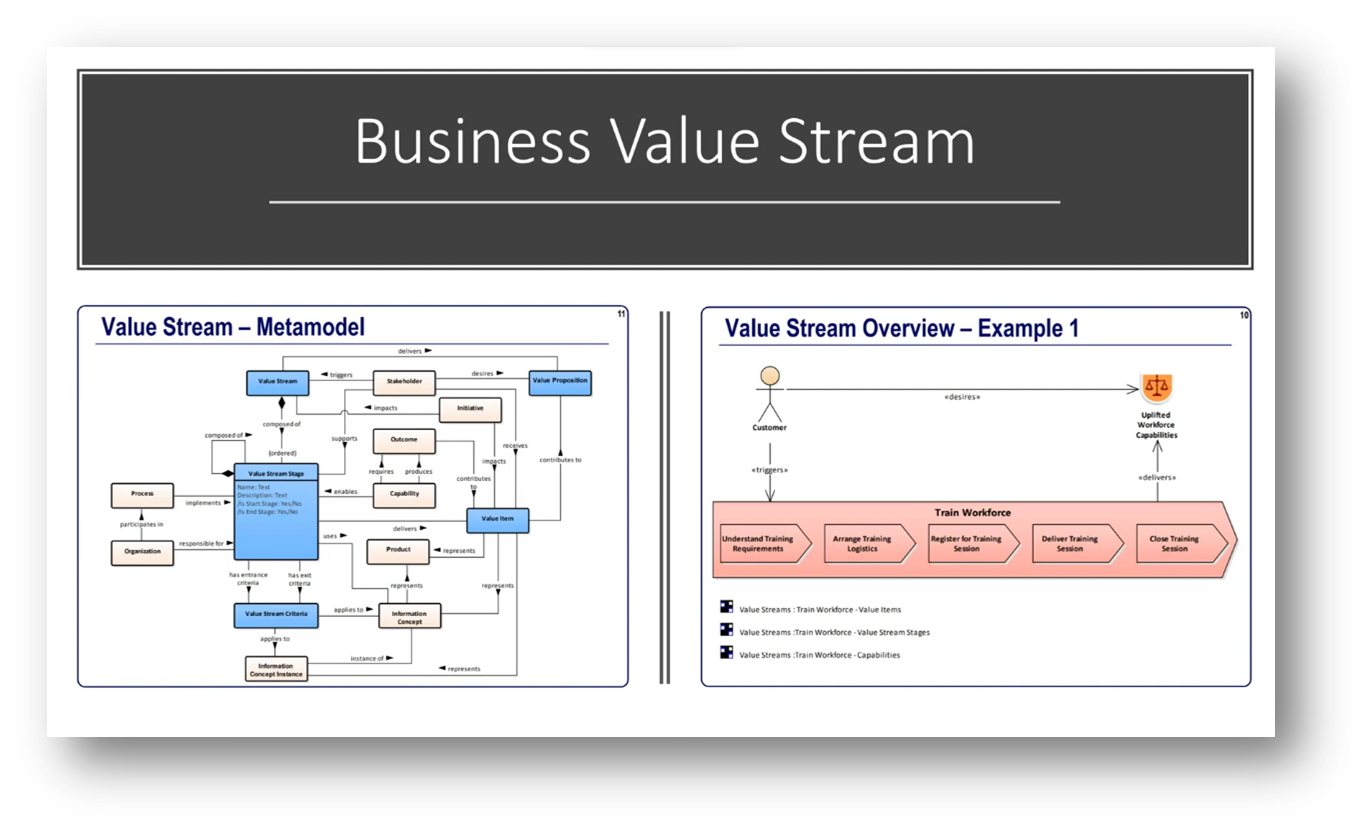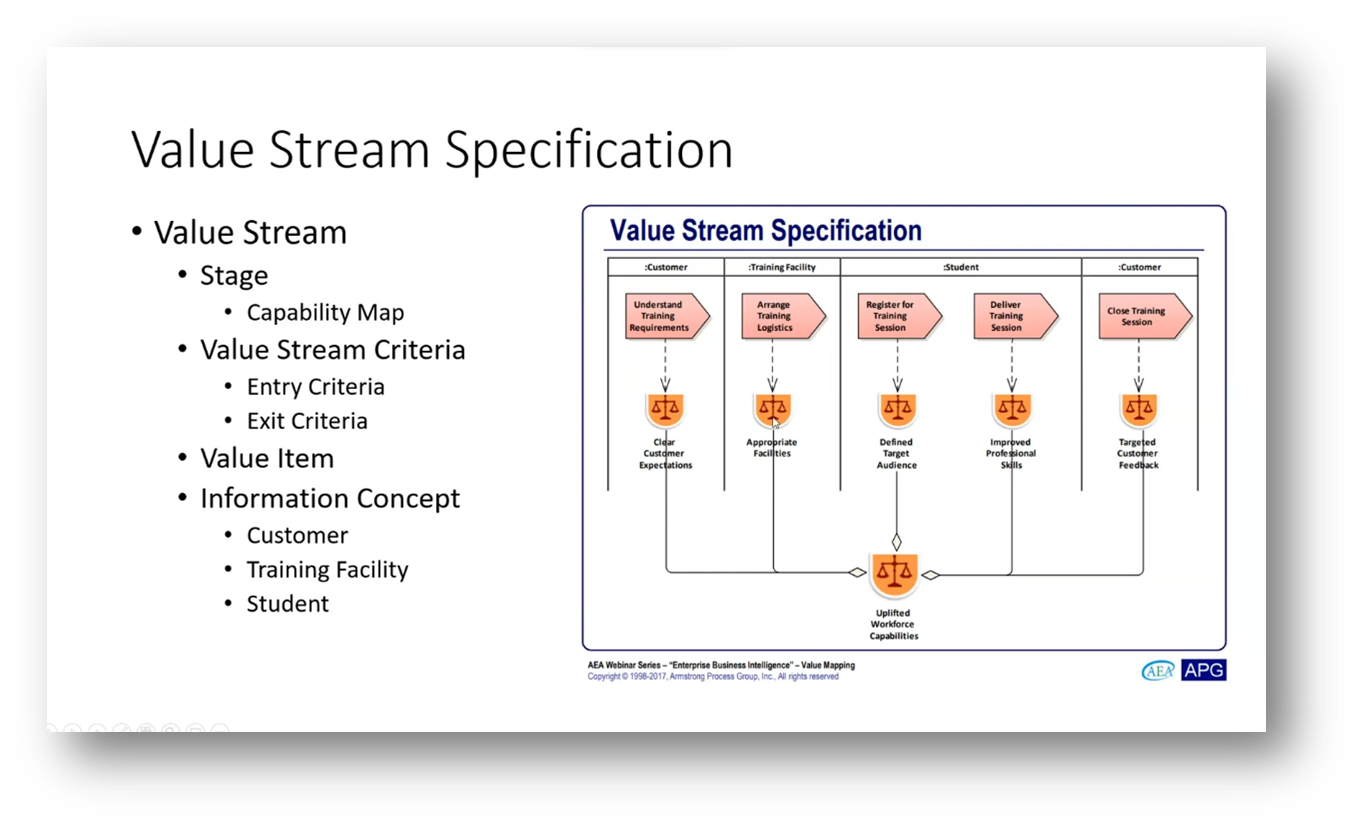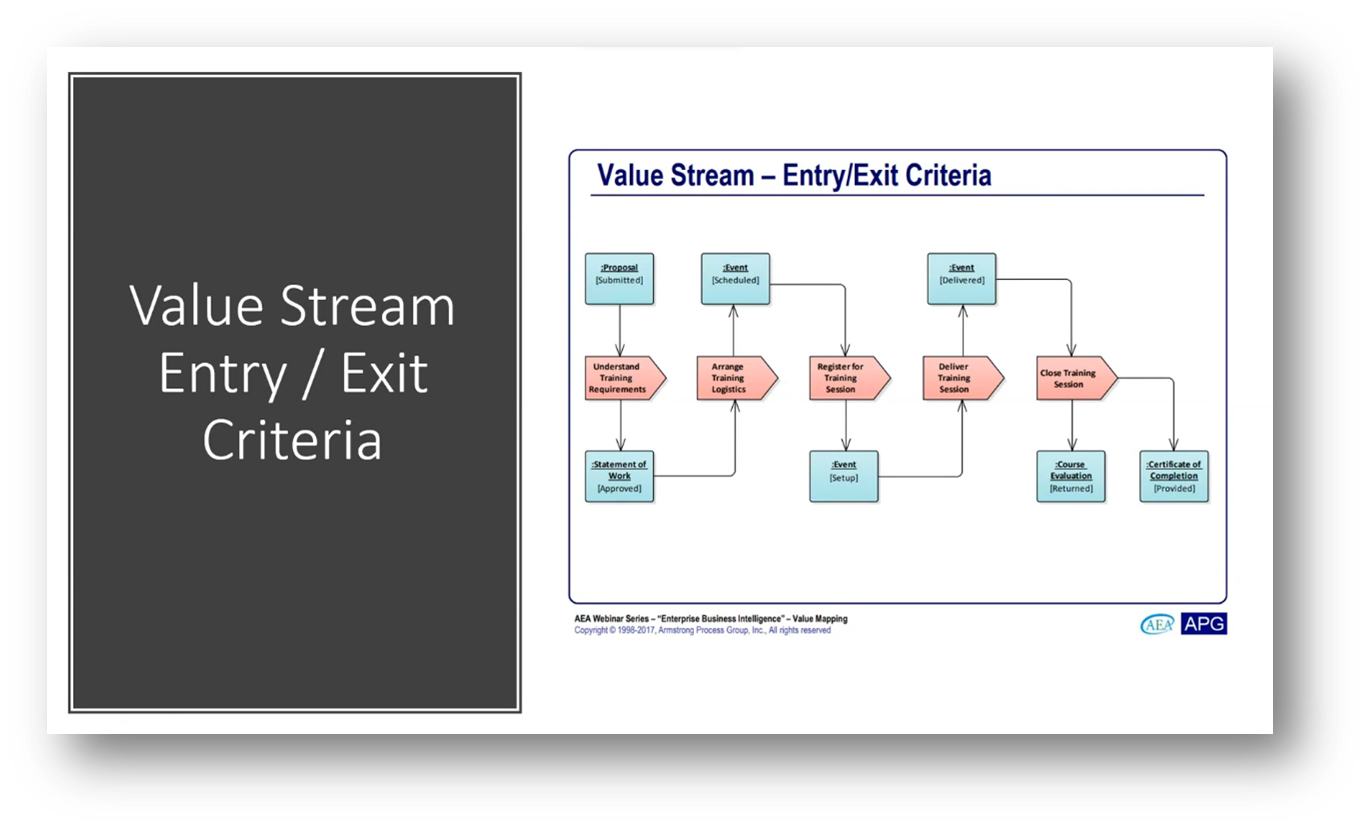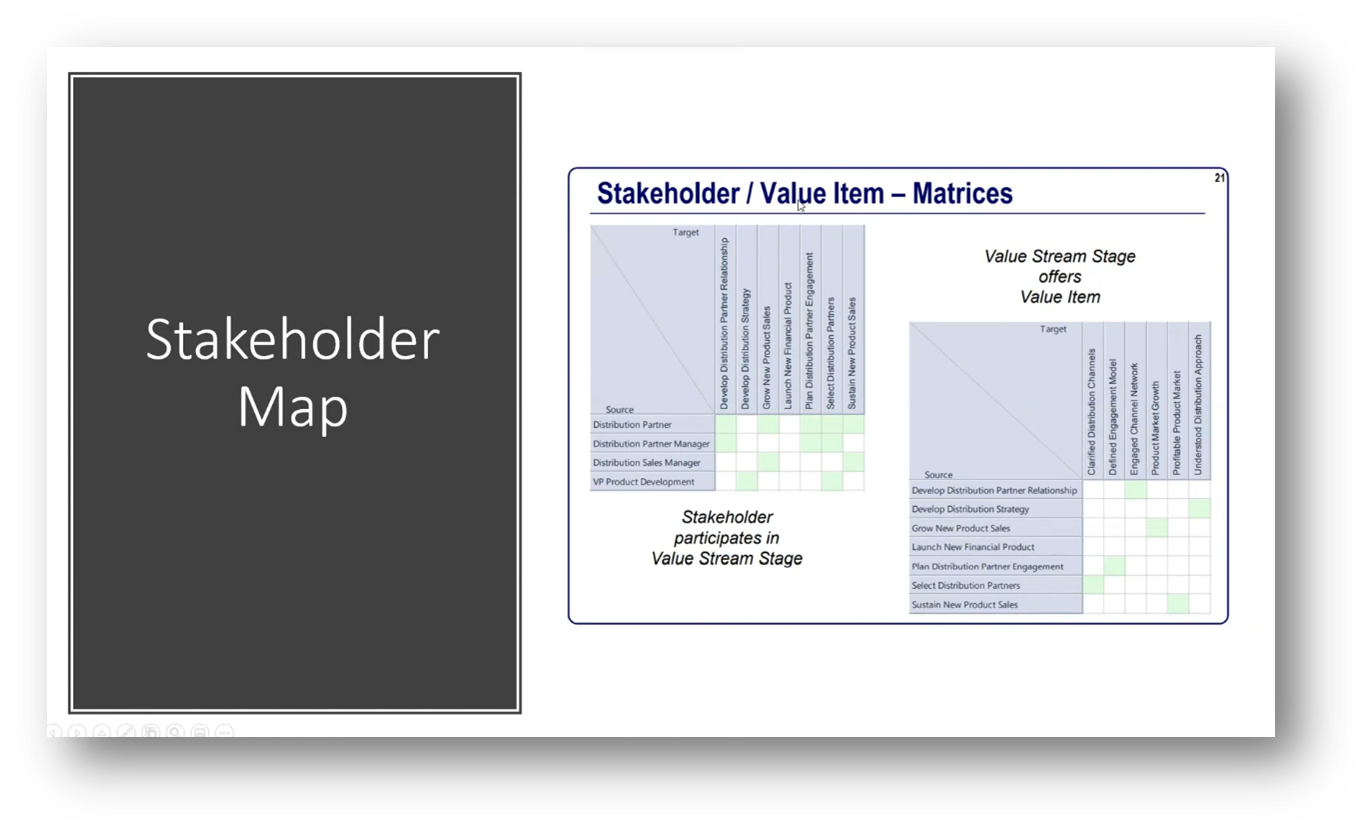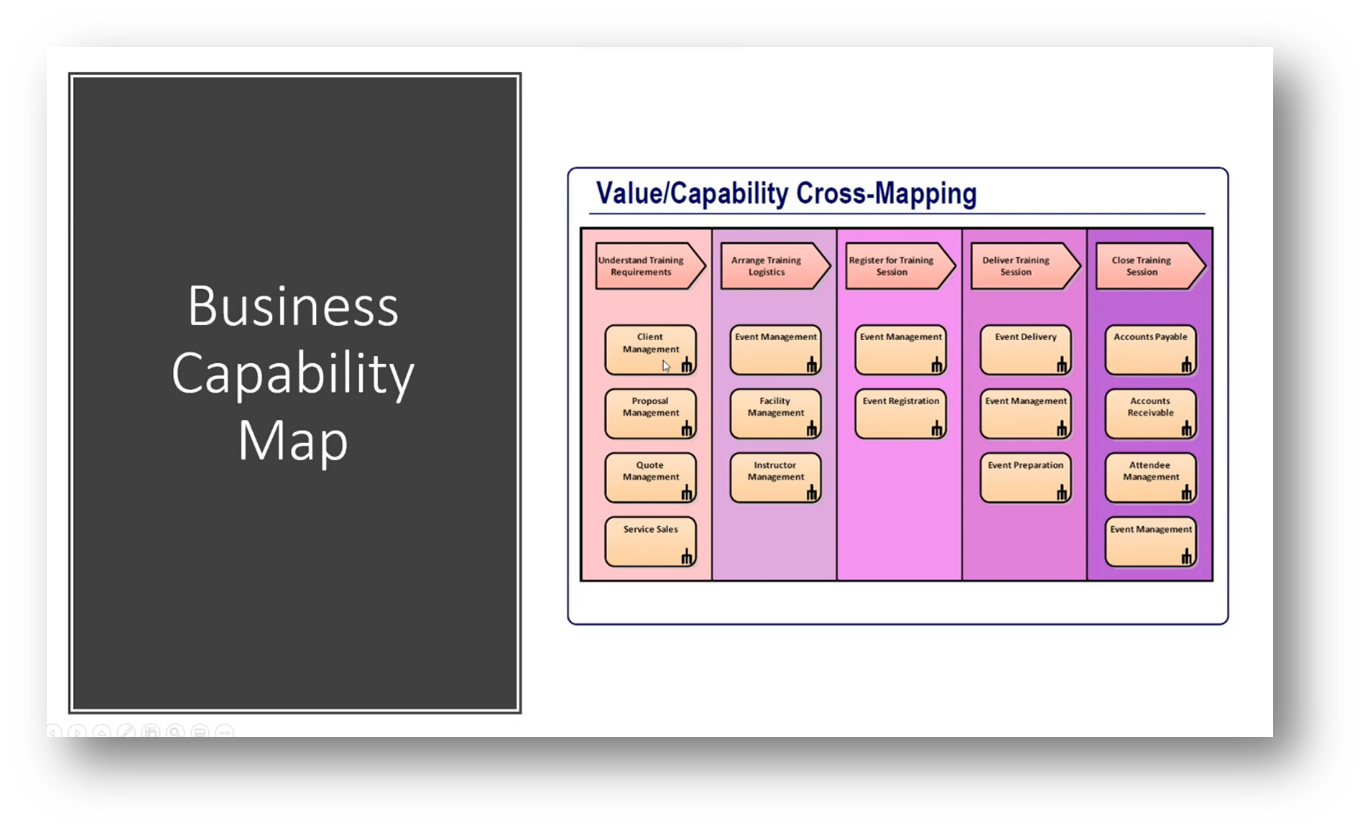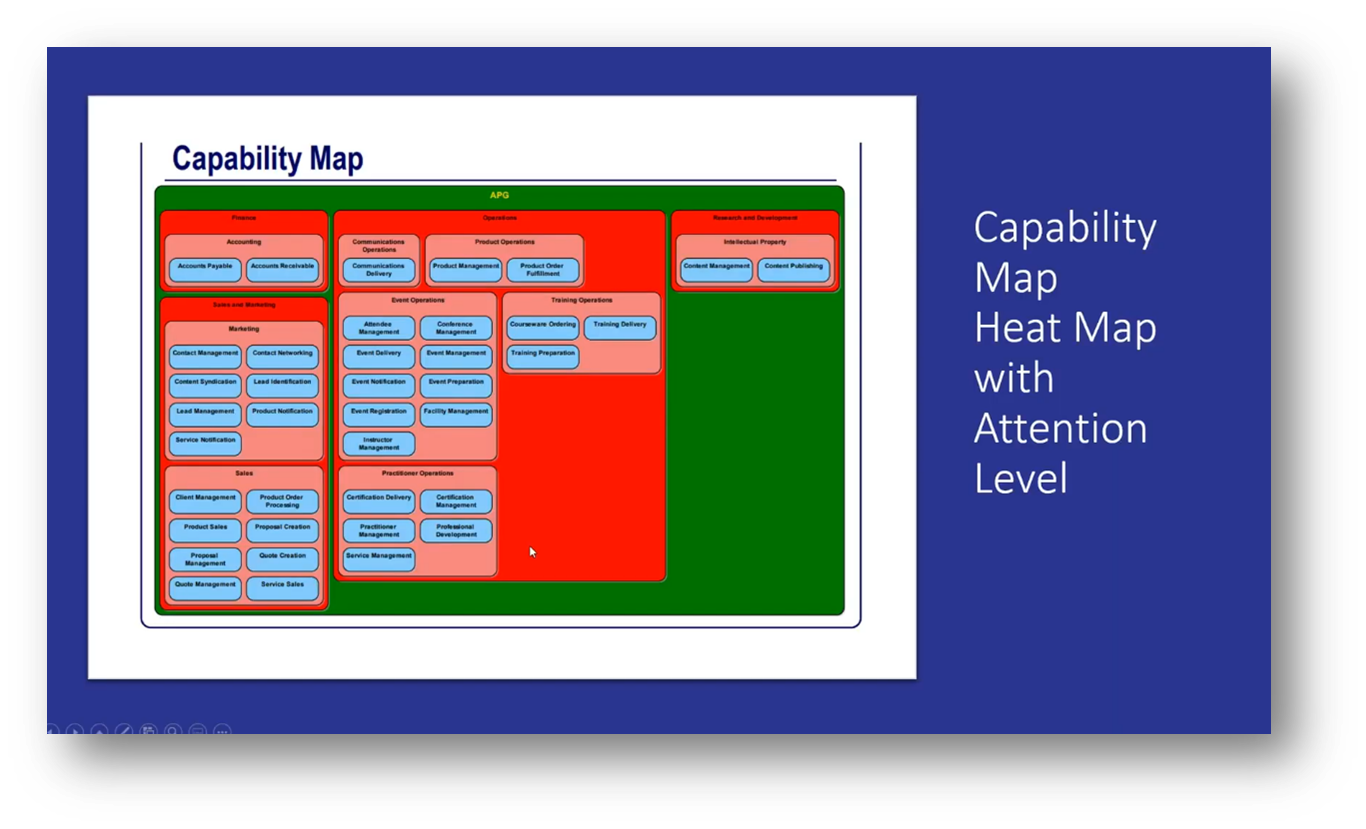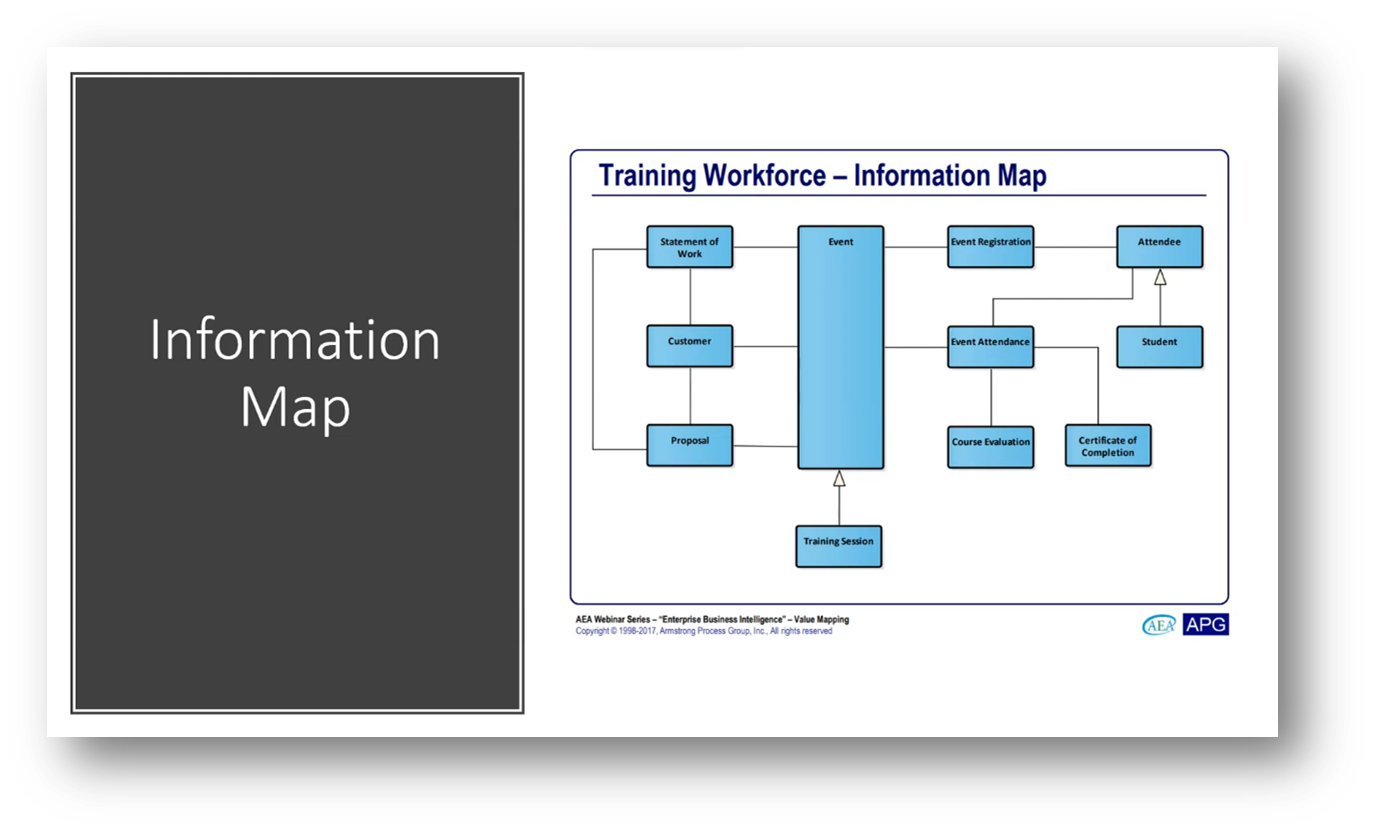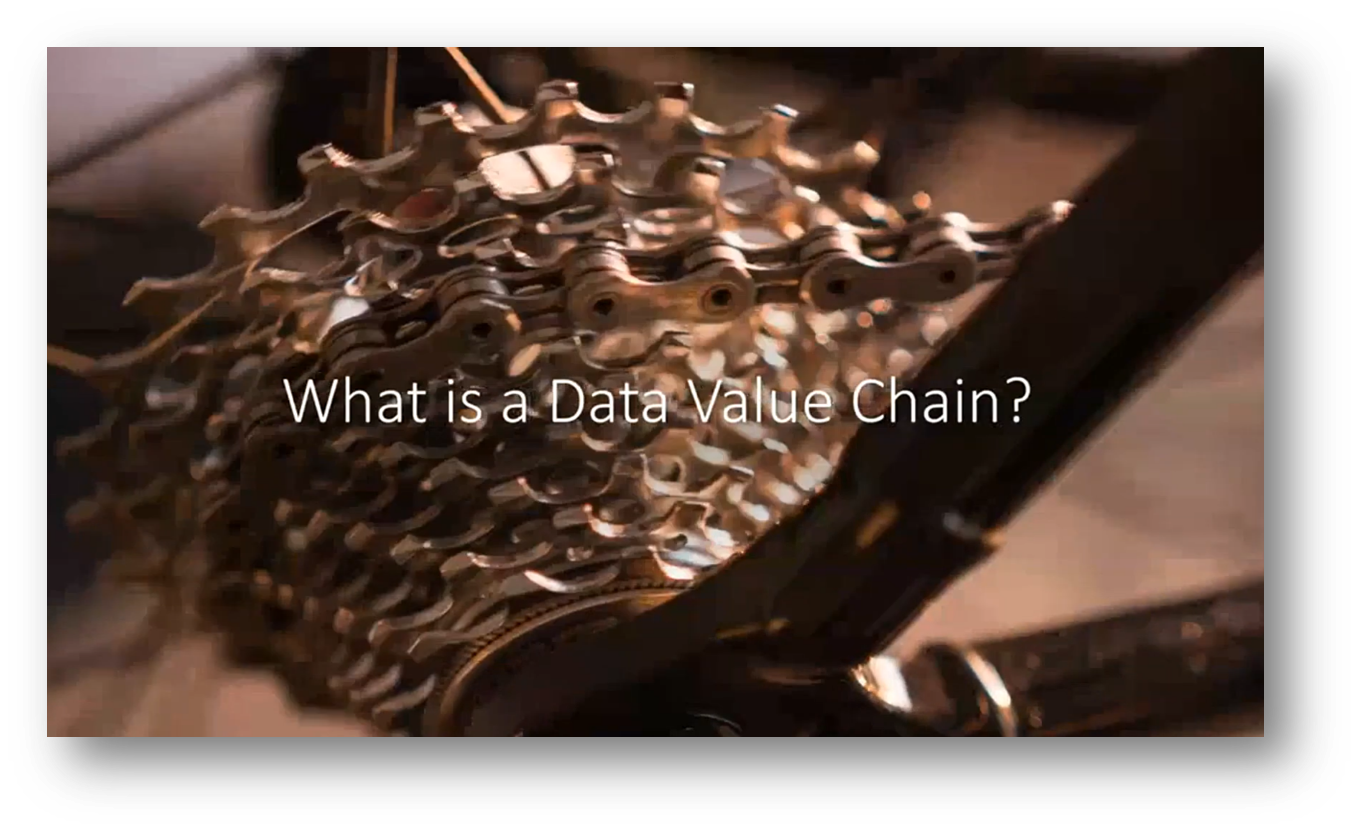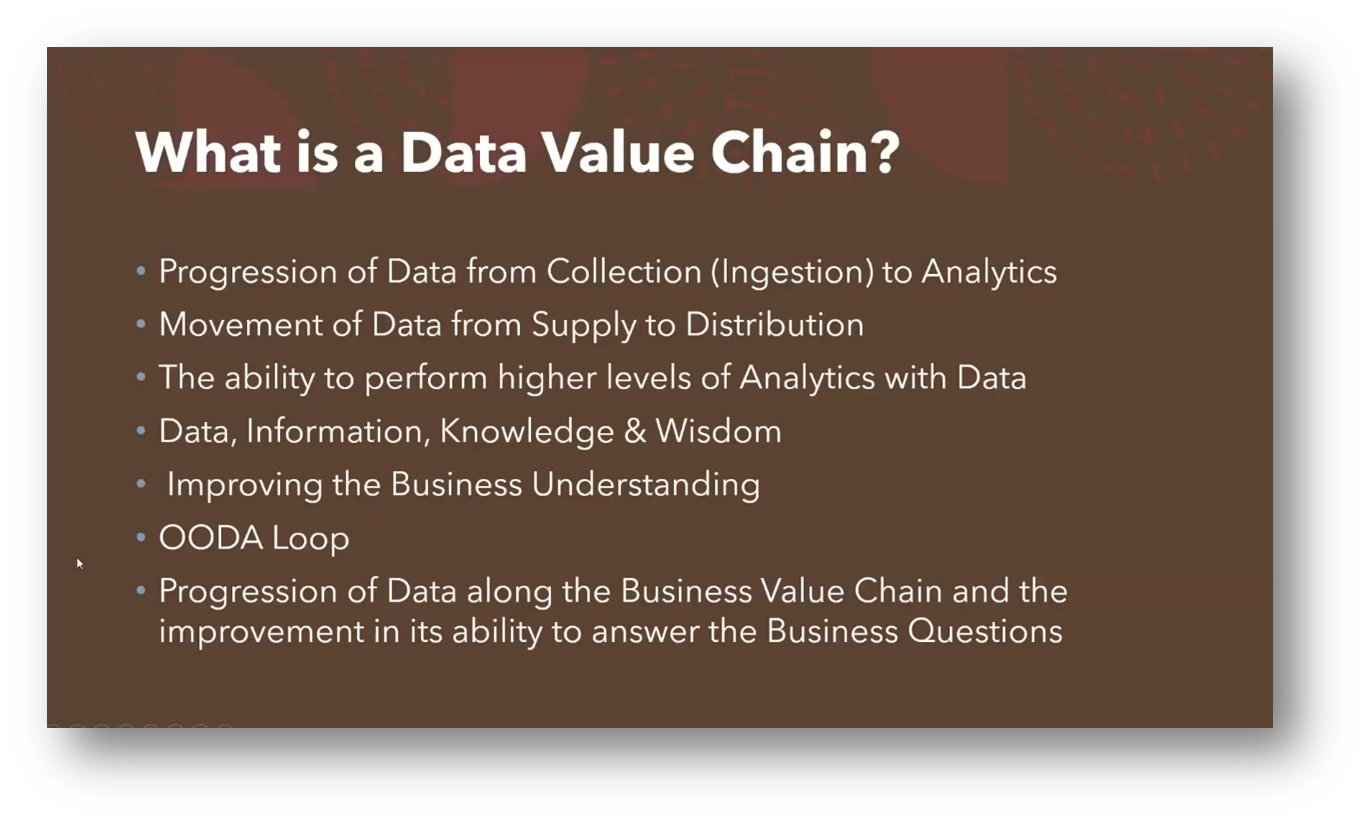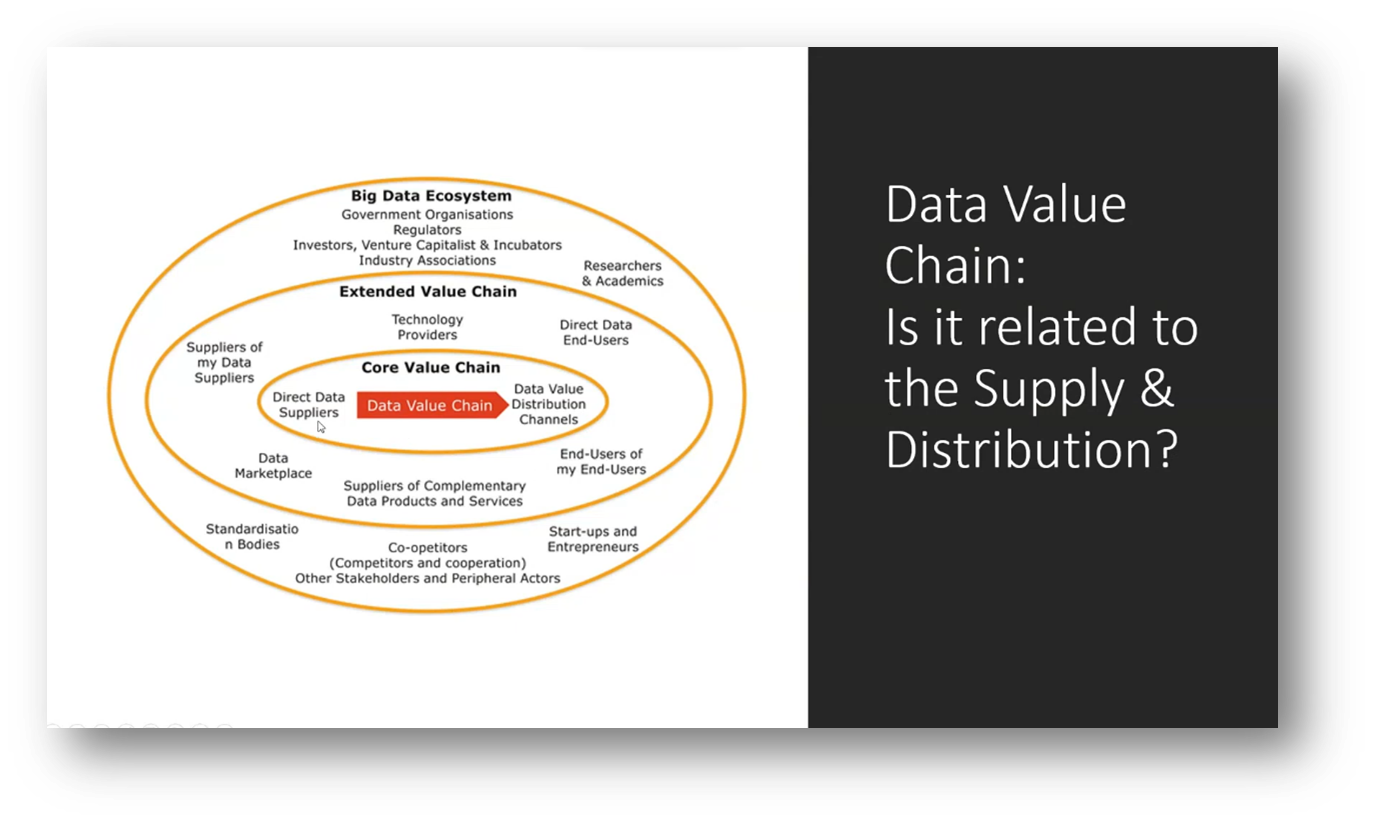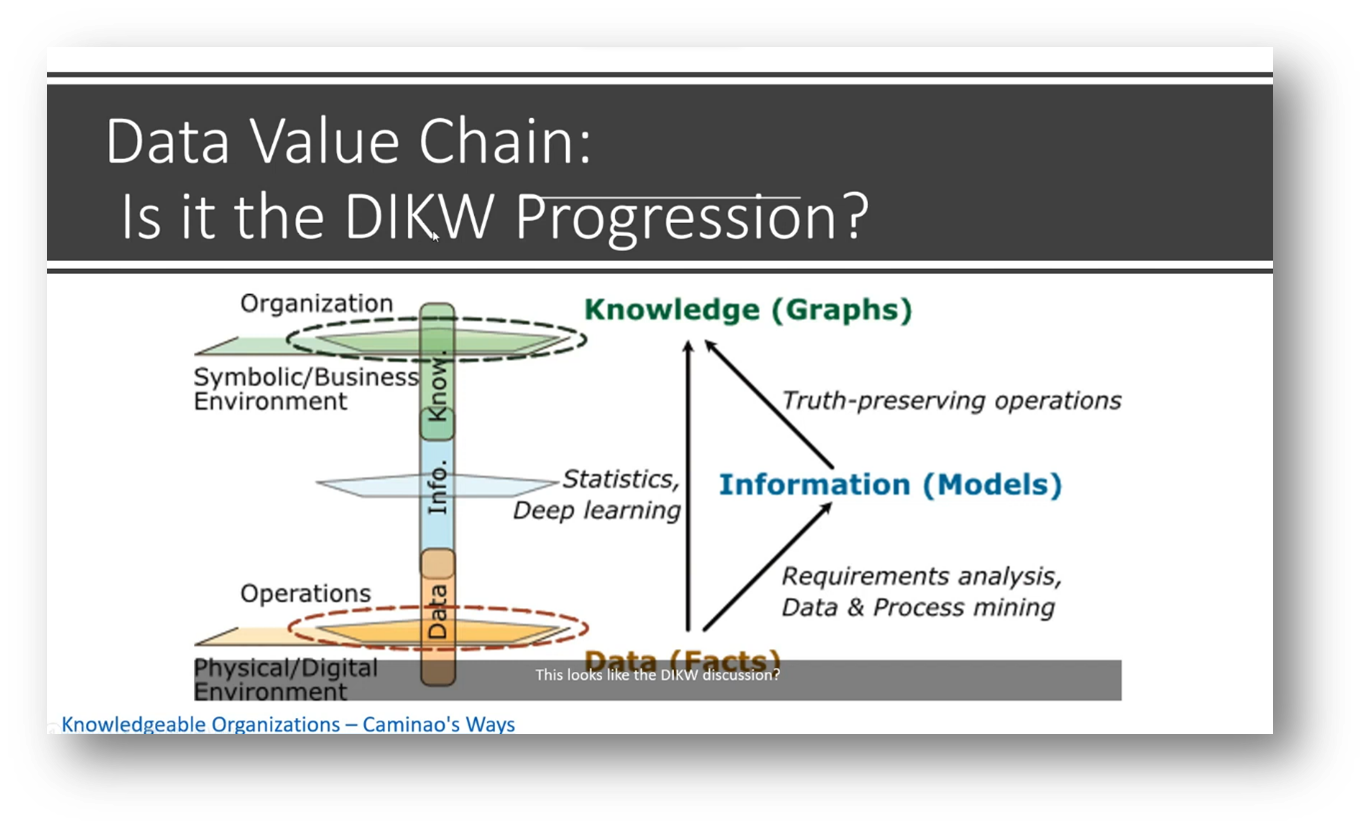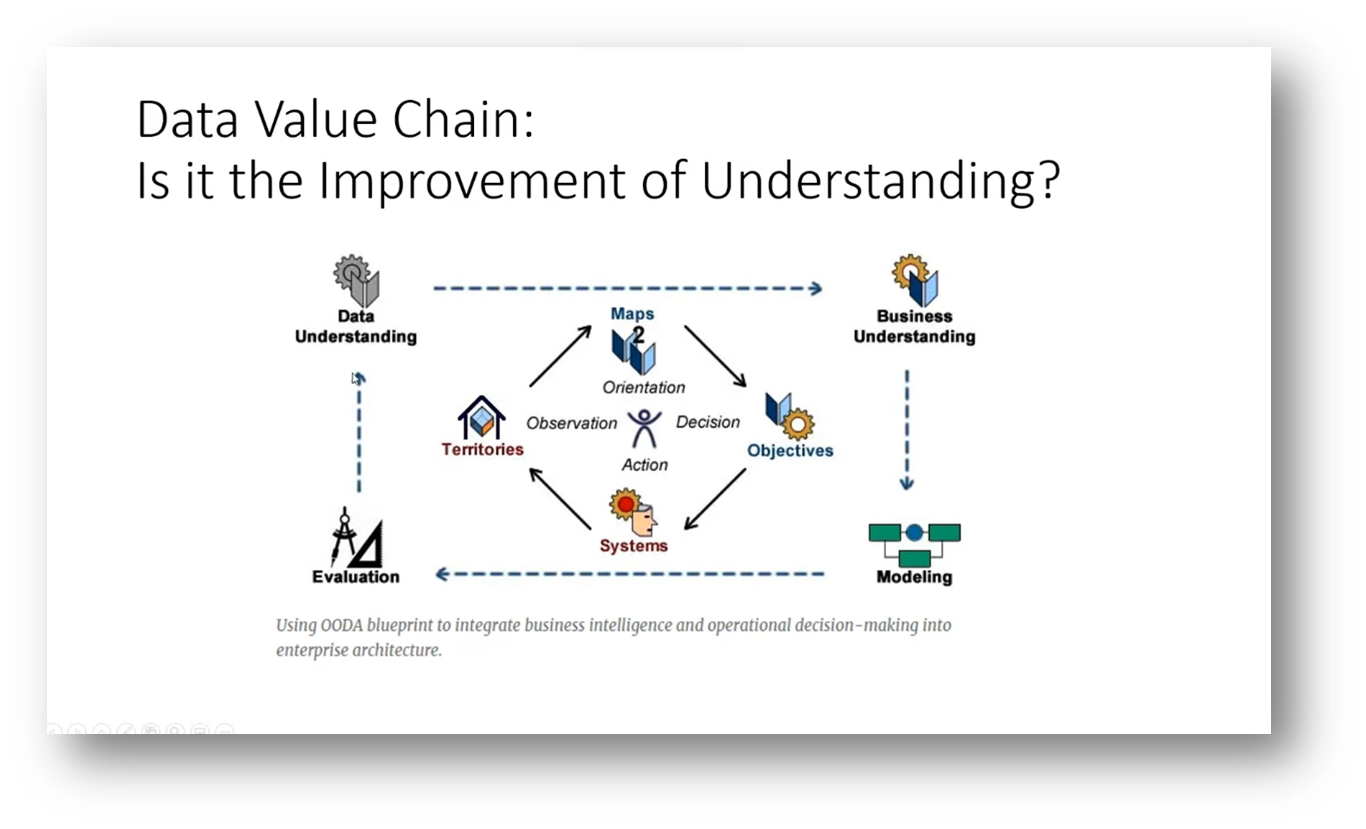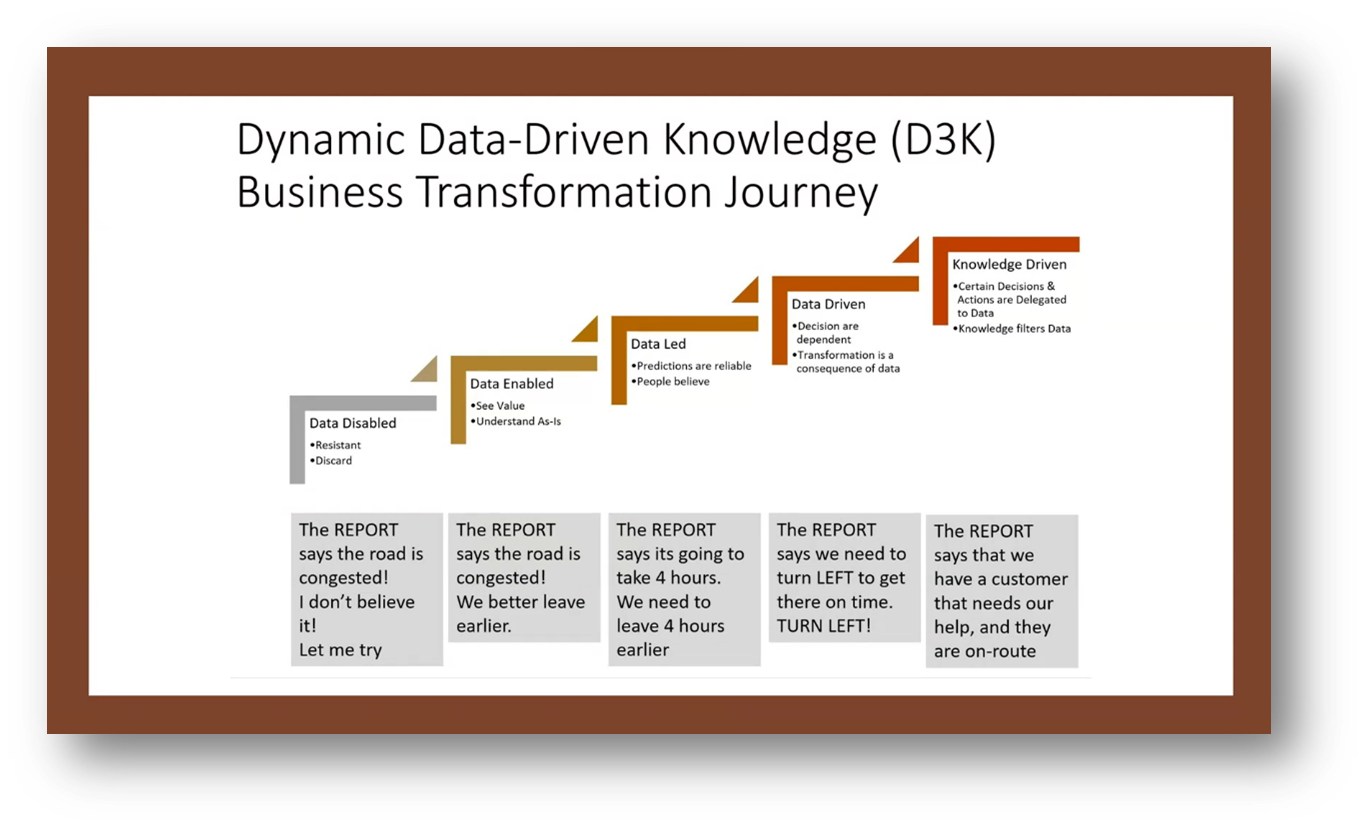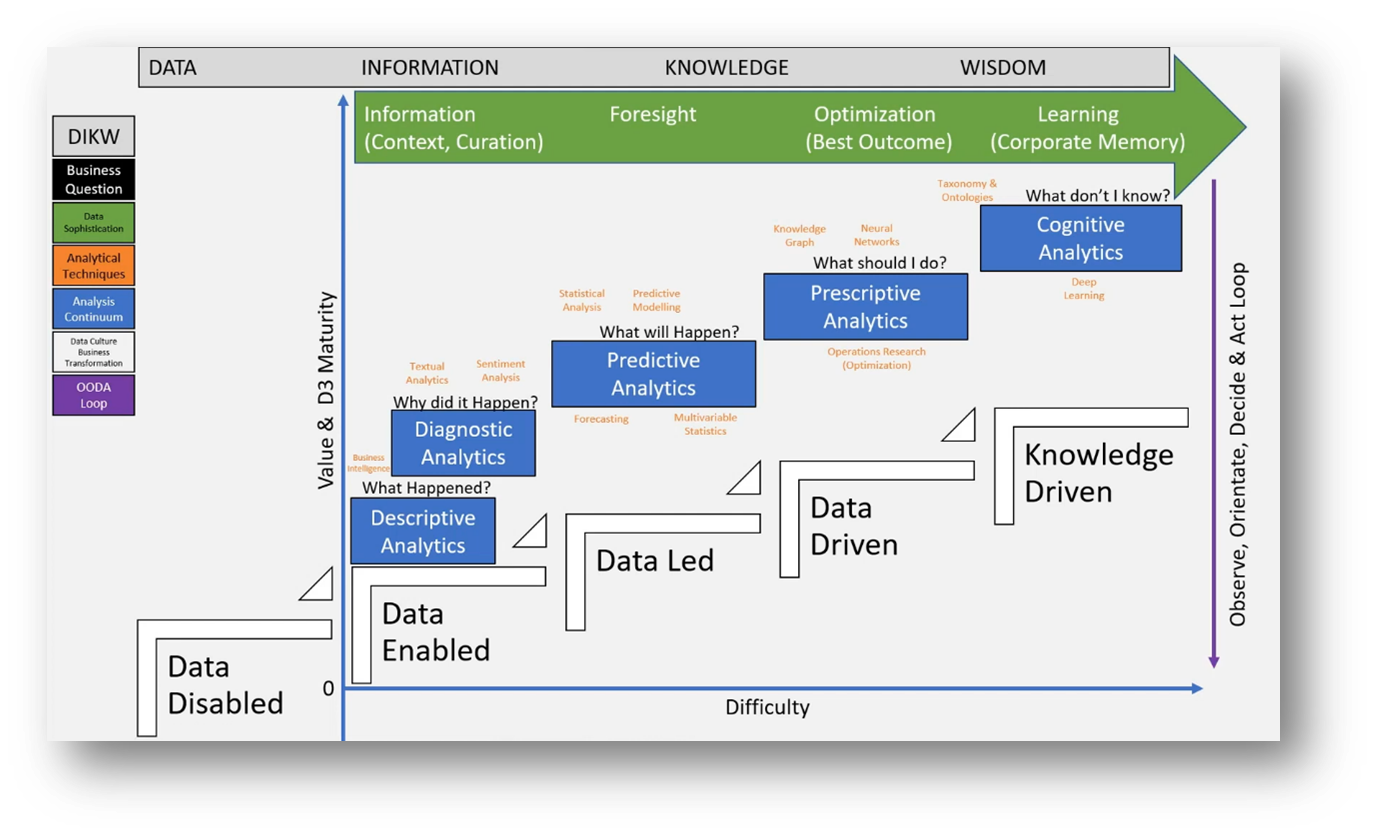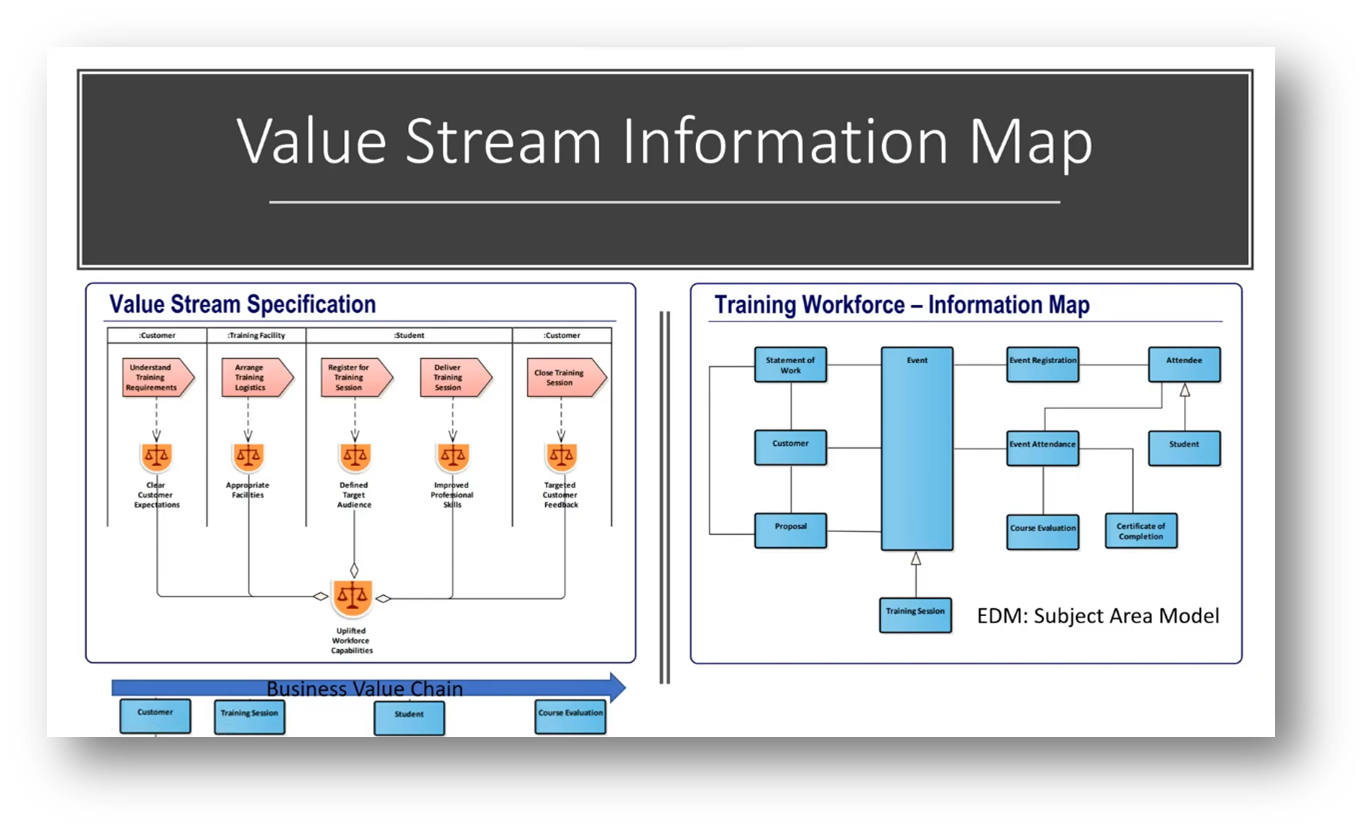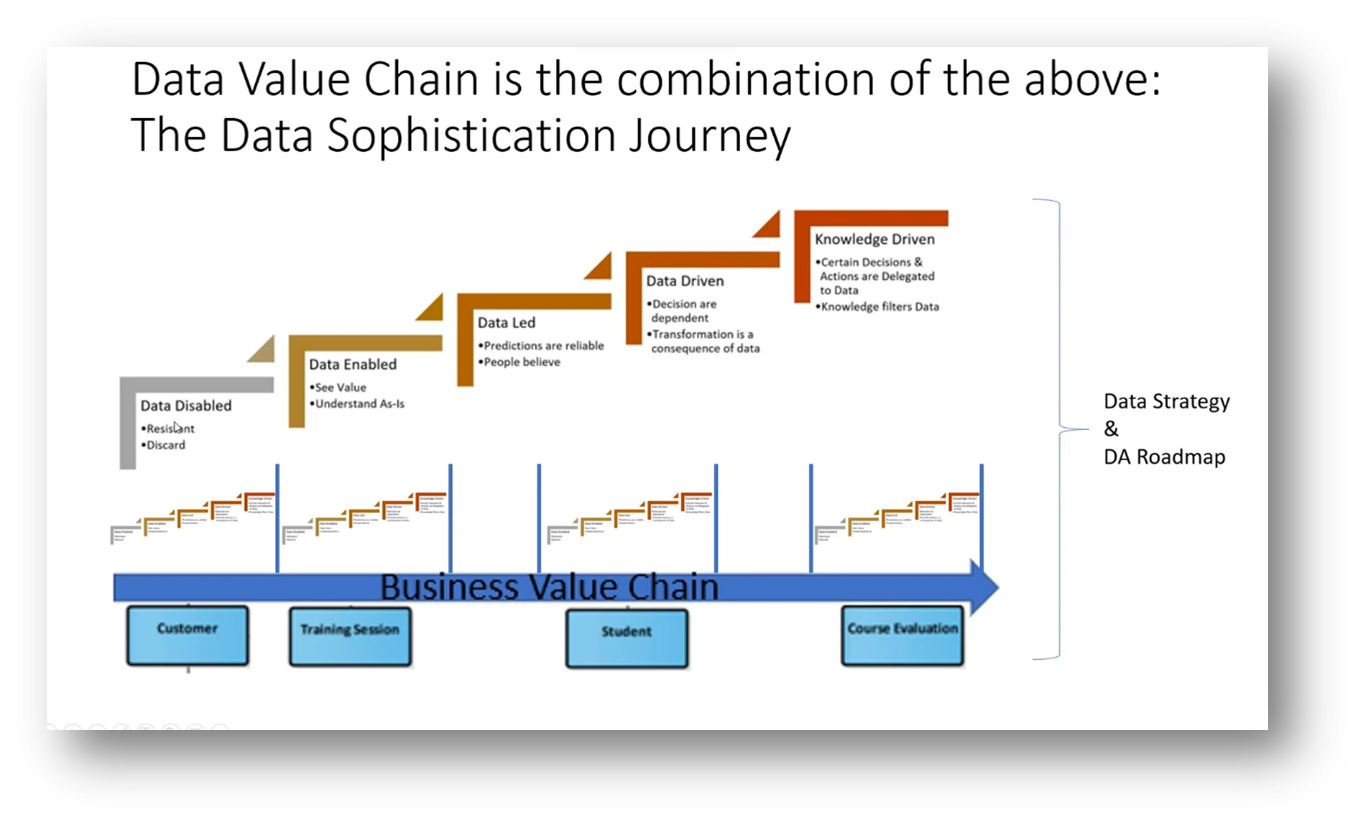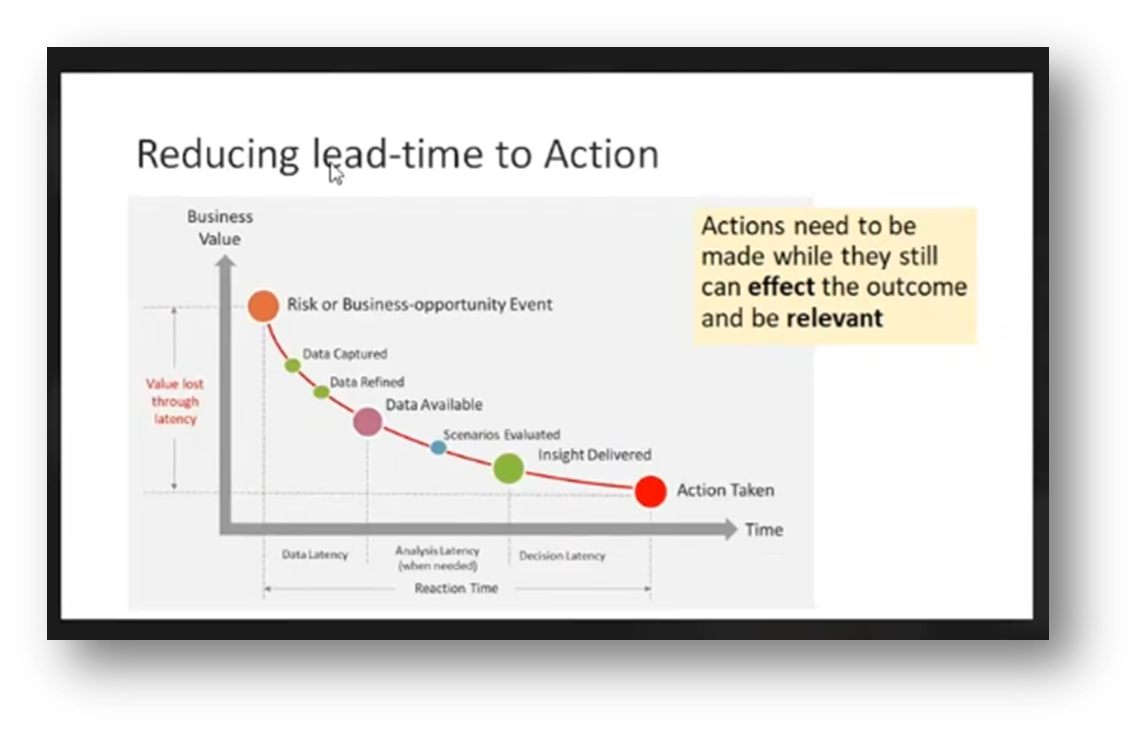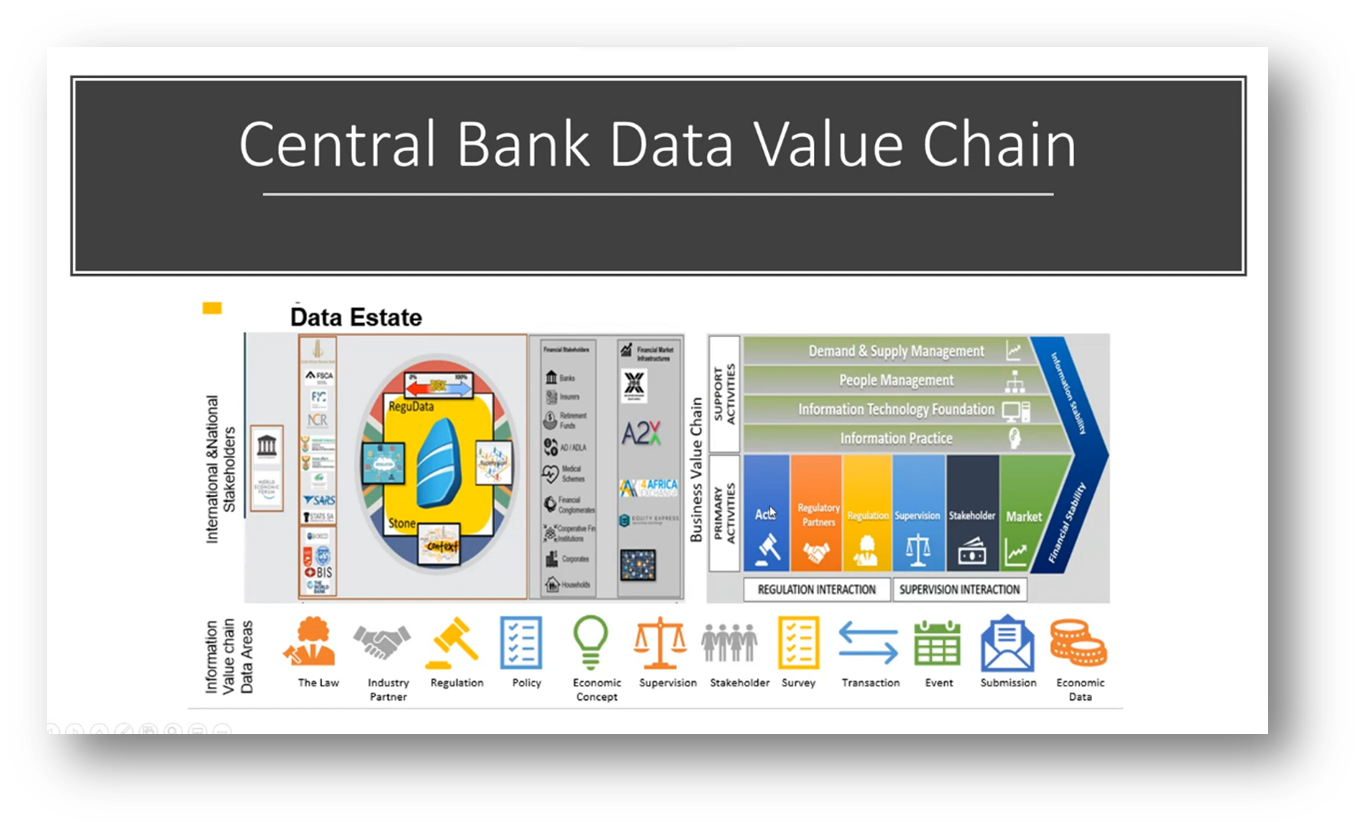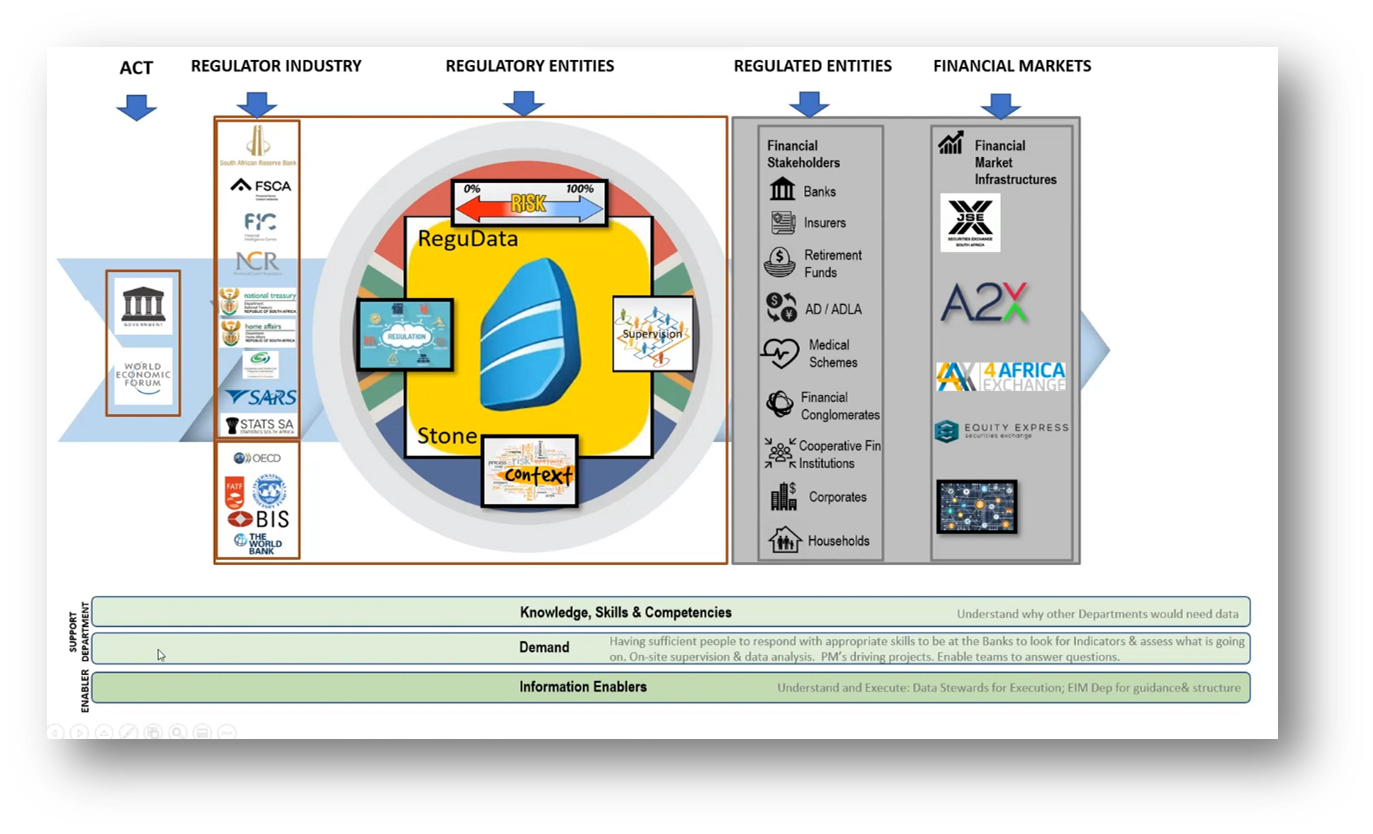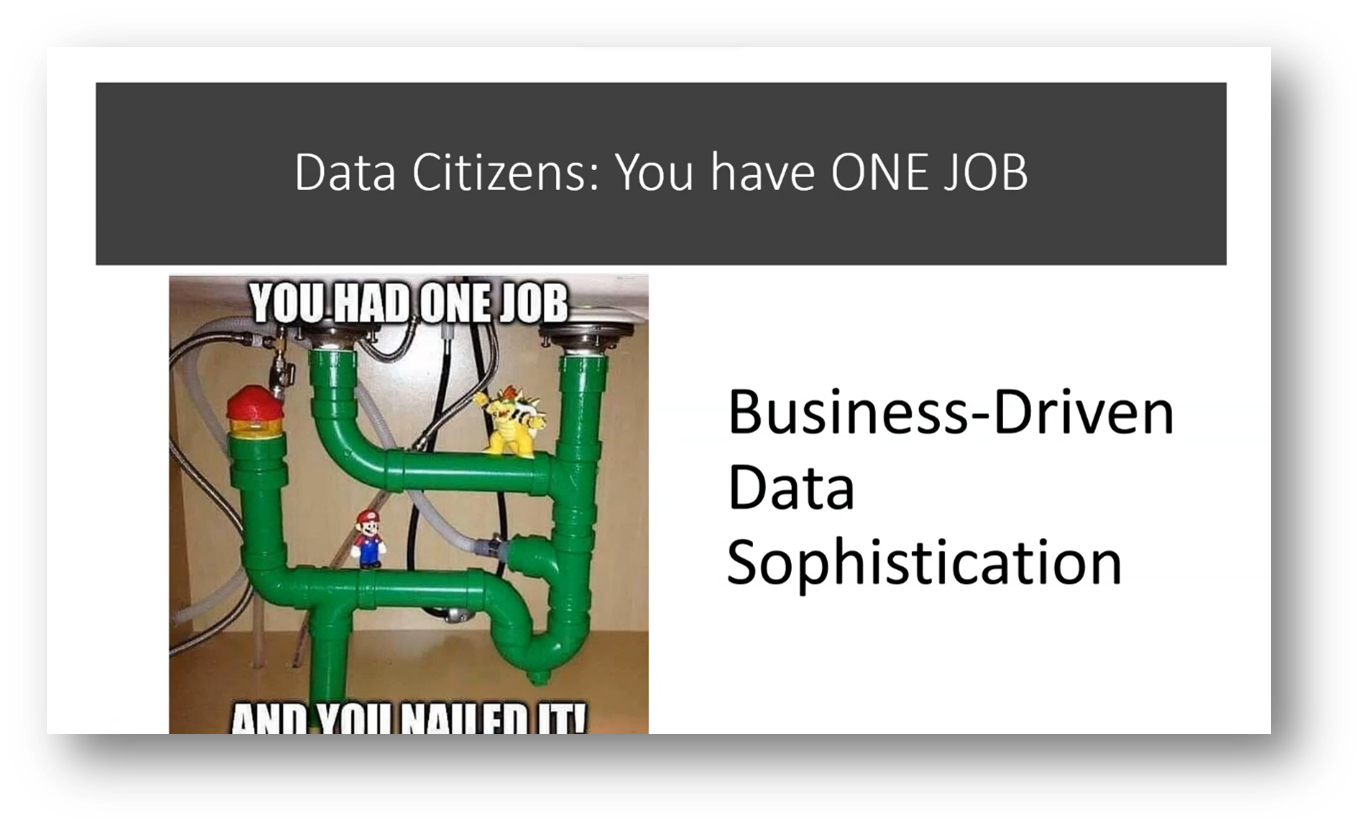Data Architecture for Data Citizens
Figure 1 Introduction Slide Data Architecture for Data Citizens
Executive Summary
This webinar outlines the key concepts related to Data Architecture and Data Citizenship and their impact on Business Strategy. Howard Diesel covers Data Products, Data Value Chains, Business Capability and Business Value Streams, data mapping and life cycle diagrams, and the importance of measuring value in Business Intelligence projects. The webinar focuses in on the significance of aligning Data Strategies with organisational vision and values and the role of data integration and centralisation in creating a data-centric architecture.
Howard finishes of the webinar by exploring the importance of reducing decision latency and measuring business value. Additionally, he discusses the impact of regulatory context on data collection is emphasised. The webinar closes on the topic of sophisticated Data Value Chain and the role of Data Estate metrics in driving business value.
Webinar Details:
Title: Data Architecture for Data Citizens
Date: 28 July 2021
Presenter: Howard Diesel
Meetup Group: Data Citizen
Write-up Author: Howard Diesel
Contents
Data Citizens and Data Architecture
Data Citizens and Data Architecture Practice
Data Citizen and Business Architecture
Data Products and Value Streams
Data Strategy and Business Architecture
Understanding Business Capability and Value Streams
Value Stream and Data Value Chain
Importance of Measuring Value in Business Intelligence Projects
Enterprise Data Model and Data Strategy Building
Data Mapping and Life Cycle Diagrams
Data Value Chain
Value Chain and Data Life Cycle
Value Chain and Data Privacy
Data-Driven and Knowledge-Driven Transformation
Creating a Data Value Chain
Data Sophistication Journey and Business Value Chain
Importance of Reducing Decision Latency and Measuring Business Value
Value Chain and Data Collection in Regulatory Context
Importance of aligning Data Strategies with vision and values
Data Integration and Centralisation
Data Virtualisation and Centralisation
Data Centric Architecture and Business Connection
Data Citizens and Data Architecture
Data Citizens are critical in bridging the gap between Data Architects and governance professionals in the business. Their responsibilities include gathering business requirements for data, explaining data challenges, and communicating necessary data decisions. Although the role of Data Citizens in Data Architecture was initially unclear, they have been recognised as essential to connecting technical aspects to business needs. In addition to Data Stewardship, Data Citizens use data to derive insights and make business decisions. Data Stewards operate at a slightly lower level than Data Citizens and focus more on technical tasks.
Data Citizens and Data Architecture Practice
In an organisation, Data Citizens are individuals who adhere to the data usage rules. The Data Architecture practice manager is responsible for establishing, designing, and defining the roadmap for the Data Architecture practice. Data Citizens contribute to designing Data Architecture by understanding and providing business requirements. The Data Architecture is responsible for delivering the Enterprise Data Model, Enterprise Data Warehouse, Decision Model, Data Estate, Data Strategy, and Data Products. Data Citizens are involved in comprehending Data Flows, Data Value Chains, Business Architecture, and Data Strategies. Although Information Technology approves the Data Architecture, it is not the primary focus. The Data Architecture practice manager's role in interpreting the organisation's needs is described using the Zachman framework.
Figure 2 Data Architecture Essential Concepts
Figure 3 Data Architecture Activities and Roles
Figure 4 Data Architecture Deliverables
Figure 5 Activities for the Data Architecture Practice Manager and Data Citizen
Data Citizen and Business Architecture
A Data Citizen is involved in inventory instantiation at the enterprise level, which refers to a data asset or data set containing customer data. They connect to the Business Architecture and map Data Architecture deliverables to the Data Architecture knowledge base. The Enterprise Data Model, decision and events, Enterprise Data Warehouse, measures and metrics (KPIs), products and services, and implementation roadmap are all key components of data stakeholders mapping. The Enterprise Data Warehouse supports decisions and events for business insights while discussing the Decision Model and insights provided are essential. Finally, the Data Value Chain and the purpose of the Data Architecture are important aspects to consider.
Figure 6 Zachman Framework and the DA Practice Manager and Data Citizen
Figure 7 Architect vs Developer
Data Products and Value Streams
Data Products are an effective way of delivering value from our information. There are two types of Data Products: those that can be sold for economic benefit and those that deliver value to the customer. Examples of Data Products that can be sold include data sets containing valuable information or reports that allow businesses to analyse their data. Additionally, travel engagement reports are mentioned as an example of a data service practice. The Value Stream is essential for delivering value to customers and meeting the Value Proposition. Therefore, understanding the Value Proposition to different customers and designing Value Streams accordingly is crucial. The Value Proposition, objectives, and goals are important components of the Business Architecture, and selling fancy reporting for certain individuals and companies for an additional price can be a lucrative Business Strategy.
Data Strategy and Business Architecture
Understanding the integration of business objectives and data is crucial for businesses to realise the value they are adding. People working in the data environment should comprehend the business side of their work to build a successful Data Strategy that aligns with the hierarchy and elements of Business Architecture. Engaging with enterprise Business Architects and conducting stakeholder analysis can save time and prevent political mishaps. Finally, delivering value to stakeholders, including suppliers and customers, is the ultimate objective of the entire Value Chain.
Figure 8 Integrating with Business Architecture Framework
Understanding Business Capability and Value Streams
An effective Data Architecture requires understanding the Business Capability and Value Stream. The former involves identifying the information concepts and processes professionals use in their work, while the latter entails analysing the stages of a Value Chain to achieve a desired outcome. A sample Value Stream might include training registration, logistics arrangement, and session delivery. Measuring progress through the Value Stream is crucial for identifying where a business might encounter obstacles or missed opportunities.
Figure 9 Business Architecture Hierarchy
Value Stream and Data Value Chain
The Value Stream of a business can occur at any level, and understanding the Value Proposition involves knowing what is needed to produce desired outcomes. The value stage produces the value items within the Value Stream, and the hierarchy of stages and items can be used in Enterprise Data Modelling and data warehouses. Metrics like the flow rate can help understand the value derived from activities like training and learning units, as recognising the value derived from these activities is essential for understanding the value being provided.
Figure 10 Business Value Stream
Importance of Measuring Value in Business Intelligence Projects
Measuring the success of Business Intelligence (BI) projects is crucial to understand the project's impact. The value metric of BI projects lies outside the bounded context as it depends on whether the taught skills add value to the workforce. It is essential to connect BI projects to the architecture and understand the decisions they help make. It is also important to collect the metrics that matter, even if they are not in the immediate context, as they can impact the value add of the project. In-depth consideration of Enterprise Data Modelling projects is necessary to evaluate the worth of the time and effort spent on them, as exemplified by cancelling a 12-year project after two years of work on the Enterprise Data Model.
Enterprise Data Model and Data Strategy Building
The importance of Enterprise Data Models in the context of data warehousing and the impact of their value on the data they contain is highlighted. Howard emphasises the significance of understanding finite state machines, time stamping events, and mapping between stakeholders and value items to develop an effective Data Strategy. He also stresses the need for Data Architects and governance personnel to gather information about stakeholders and their data-related challenges, identify the stages that offer value items, and bring in capabilities to understand the Value Stream at the top with stages.
Figure 11 Value Stream Specification
Figure 12 Value Stream Entry / Exit Criteria
Data Mapping and Life Cycle Diagrams
Event management involves managing logistics, training, delivery, and closing. A heat map is utilised to identify different data areas across the capability map. Additionally, data mapping and life cycle diagrams are important tools in understanding the life cycle of different concepts. Consistency in levels of capabilities is crucial across departments or areas. An information map, derived from capabilities, helps identify Master Data and other important elements. Nouns are used to develop information concepts and understand capabilities at different levels. This information map also helps identify core business concepts and required information. A life cycle diagram is built for each concept to understand its life cycle, which connects to the entry and exit conditions of capabilities. The Value Chain and entry/exit conditions drive the training event life cycle. A detailed understanding of life cycles and capabilities is crucial for effective data mapping.
Figure 13 Stakeholder Map
Figure 14 Business Capability Map
Figure 15 Capability Map Heat Map with Attention Level
Figure 16 Information Map
Data Value Chain
A well-defined exit condition is crucial to the life cycle of data or training events. To ensure completeness in the Data Value Chain, it is necessary to transform and enrich data, remove and create enhancements, and have the necessary capabilities and processes to move data from one stage to another. A life cycle diagram can be used to assess if capabilities and processes are complete and if any stage is missing in business analysis. The generic data life cycle comprises stages such as disposing of data, which may reveal missing steps in the analysis process. Though it is unclear, the progression of data from collection to analytics defines the Value Chain.
Figure 17 What is a Data Value Chain?
Value Chain and Data Life Cycle
Various perspectives on increasing the value of data are outlined. These include the movement of data from supply to distribution, the progression of data along a Value Chain from data to information, knowledge and wisdom, improving business understanding and the Observation Orientation Decision-making Action (OODA) loop, the discovery of insights and answering business questions, and quantifying the value and linking it to business. The importance of the Data Value Chain, which consists of collecting, publishing, uptake, impact, use change, and reuse scenarios, is highlighted. Howard compares the Data Value Chain to a data life cycle and emphasises the importance of the disposal phase.
Figure 18 What is a Data Value Chain?
Figure 19 The Data Value Chain: Is it the Data Lifecycle?
Value Chain and Data Privacy
Howard covers the importance of Data Privacy, the supply and distribution of data within organisations, and the Value Chain in a Big Data scenario. He discusses stakeholders involved in data distribution, mapping value to the type of analytics being done, and the need for predictive and prescriptive analytics for intelligent decision-making. The progression of data from facts to wisdom, analytical approaches to data, building models and making decisions according to objectives, and taking actions through systems and observing outcomes are also highlighted. Proper disposal of data within the organisation, mapping data flow and lineage, and improving understanding and evaluation of data are also addressed.
Figure 20 Data Value Chain: Is it Related to the Supply and Distribution?
Figure 21 Data Value Chain: Is it the Level of Analytics?
Figure 22 Data Value Chain: Is it the DIKW Progression?
Figure 23 Data Value Chain: Is it the Improvement of Understanding?
Data-Driven and Knowledge-Driven Transformation
Adding knowledge to data-driven transformation is emphasised. Howard highlights the need to move from data to information to knowledge to wisdom to get a complete understanding. Predictive analytics can describe what will happen, while Business Intelligence and analytics answer what happened and why. The aim is to move the organisation from being "data-disabled" to "data-enabled" through different levels of analytics. However, Howard cautions against jumping to prescriptive analytics without first understanding predictive, diagnostic, and results. The process adds value and maturity to the organisation despite the difficulty of moving from data to wisdom.
Figure 24 D3K Business Transformation Journey
Figure 25 Value and D3 Maturity
Creating a Data Value Chain
The process of answering questions involves techniques such as probing and hypotheses, including using a double Observation Orientation Decision-Making Action (OODA) loop. Data culture transformation involves comprehending how businesses perceive and use data. The Data Value Chain can be mapped onto the business Value Chain to create a link between data concepts and business value. Focusing on specific areas of data or business can be part of a transformation journey. Strategies and roadmaps for building Data Value Chains involve identifying and addressing specific business concepts using metrics and evaluation.
Figure 26 Value Stream Information Map
Data Sophistication Journey and Business Value Chain
Howard discusses the journey of data sophistication and emphasises the importance of improving data maturity in the business Value Chain. The connection between data and business requirements is highlighted, with the Data Value Chain equivalent to the business Value Chain from a data perspective. Howard discusses the multiple dimensions of the value of data and suggests that it is a combination of factors, progressing from facts to information to knowledge and wisdom at the data culture level. The importance of translating the transformation of data to understand the business and support in achieving objectives is emphasised.
Figure 27 The Data Sophistication Journey
Importance of Reducing Decision Latency and Measuring Business Value
The OODA loop concept, created by John Boyd, stresses the significance of decreasing the time to act to stay ahead of competitors. Shortening the loop leads to faster observation, orientation, decision-making, and action, which can significantly impact the market. Reducing decision latency, data latency, and analytics latency is crucial to enhance the value delivered to the business. Executives should offer a clear steer on their business Value Proposition to align with the right decision-making processes. Measuring business value items and objectives is important to connect with the right Business Strategy. While advanced analytics can be helpful, simpler analytics may be enough to make important decisions and save time.
Figure 28 Reducing Lead-time to Action
Value Chain and Data Collection in Regulatory Context
In business, aligning the Value Chain and the Value Proposition to deliver value effectively is crucial. This involves understanding the business Value Chain in a regulatory context, including regulatory partners, regulations, supervision, stakeholders, and the market. Similarly, the data value information chain must be considered, highlighting the need for data related to laws, guidelines, policies, and economic partners. Policies significantly impact regulations, leading to a better understanding of economic concepts and data.
Figure 29 Central Bank Data Value Chain
Importance of aligning Data Strategies with vision and values
Howard covers various aspects of Data Management and strategy. He highlights the use of the porta model to identify supporting activities for the Data Estate, knowledge, skills, and competencies necessary for Data Management. Howard emphasises the importance of aligning Value Chains with the organisation's vision, mission, and values to foster growth. Additionally, he underlines the significance of connecting Data Strategy with the overall business goals and the emergence of data mesh as a topic of discussion in the industry. An example of regulatory vision and policy harmonisation is provided.
Figure 30 Central Bank Data Value Chain
Figure 31 Data Citizens: You have One Job
Data Integration and Centralisation
The conversation revolves around transitioning from centralised enterprises to more distributed yet secure models, focusing on choosing the right operating model and federation level, particularly in relation to data lakes. Importance is placed on organising operating models and Value Chains, delivering value at each level, and appropriately sharing data. A trend towards decentralising data prompts the need to use open data platform techniques for integrating and sharing data effectively. Additionally, there is a need to rethink the approach of collecting excessive data and instead send algorithms to data. The challenge lies in convincing people of the benefits of sharing data with a centralised centre and understanding the value they receive.
Data Virtualisation and Centralisation
In the realm of Data Management, challenges arise from internal politics and silos, which can lead to fragmentation. To combat this, a single-door policy has been implemented to control data flow. Additionally, there is a growing need for easy and simple ways of sharing and connecting data. Germany and Spain have differing approaches to handling data and privacy concerns. Data virtualisation has proven beneficial in building memory models and issuing queries, but challenges and benefits also emerge when prototyping and virtualising data models. A centralised glossary is recommended to harmonise Data Management with distributed responsibility among team members.
Data Centric Architecture and Business Connection
Data-centric architecture relies on ontologies, which serve as detailed glossaries that enable multiple levels of semantic understanding. This approach involves extending a core ontology to different domains while mapping it back to the core ontology. Providers are accountable for the data, ensuring holistic responsibility. The core ontology is kept organised and extended when necessary, rather than creating one massive model. The approach also connects data practices with Business Architecture to add value and improve processes. Understanding the business perspective makes it easier to identify what data or information is required, thus preventing unnecessary efforts.
If you would like to join the discussion, please visit our community platform, the Data Professional Expedition.
Additionally, if you would like to be a guest speaker on a future webinar, kindly contact Debbie (social@modelwaresystems.com)
Don’t forget to join our exciting LinkedIn and Meetup data communities not to miss out!

